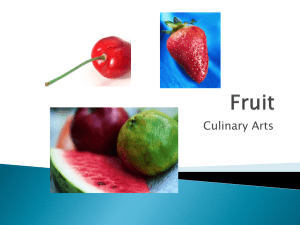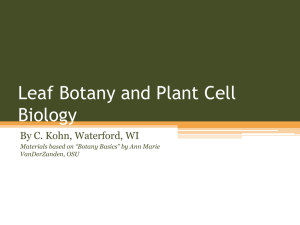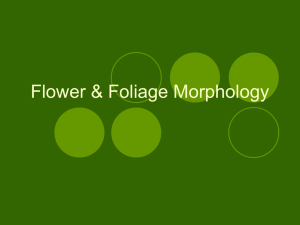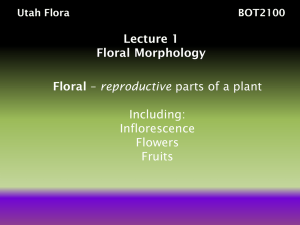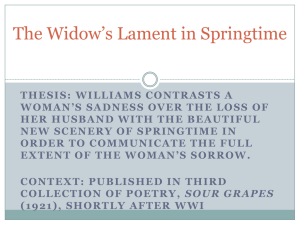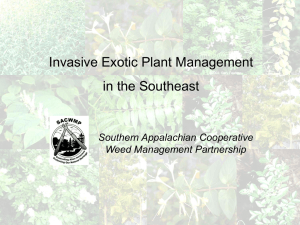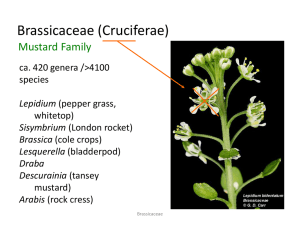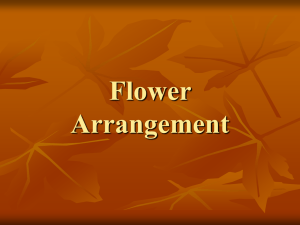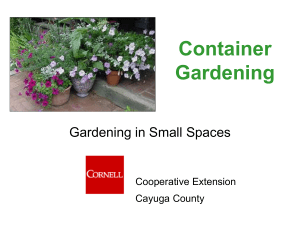Flowers Inflorescences and Fruits
advertisement
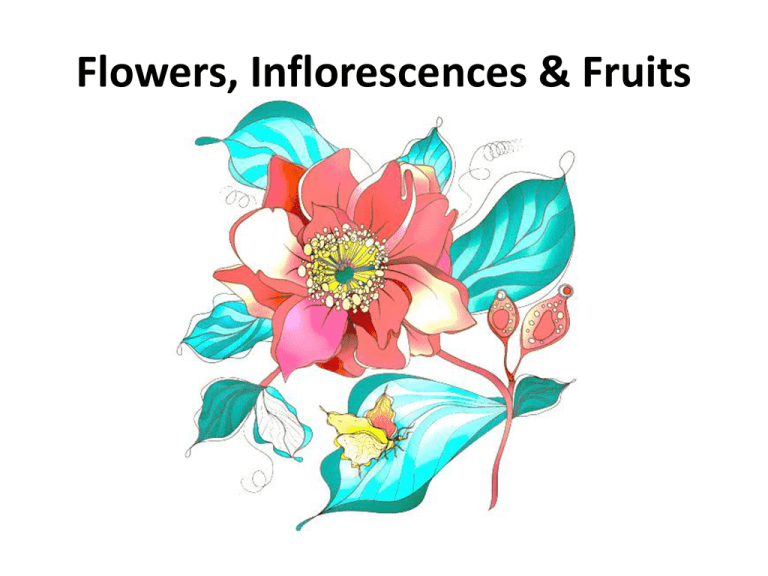
Flowers, Inflorescences & Fruits Flowers, Inflorescence & Fruits • Floral characteristics are the most commonly features to identify plants • Much more reliable than vegetative characteristics Flower • A typical flower is a stem tip bearing two whorls of appendages that are sterile and two that are fertile • All four whorls are considered to be modified leaves Flower • Typical flower – 4 main parts Flower • Sterile parts – Sepals: protect flower bud • All sepals called calyx – Petals: pretty parts that attract pollinators • All petals called corolla – Calyx and corolla make up the perianth Flower • Fertile parts – Stamens • Male reproductive structures – Anther – Filaments – All stamens called androecium Flower • Fertile parts – Carpel • Stigma • Style • Ovary – All carpels called the gynoecium Presence or Absence of Parts Terms Applied to Individual Flowers • Complete: has all the floral parts – – – – Sepals Petals Stamens Carpels Presence or Absence of Parts Terms Applied to Individual Flowers • Incomplete: missing one of more of the floral parts Ginger flower missing petals Presence or Absence of Parts Terms Applied to Individual Flowers • Perfect (=bisexual): flower with both stamens and carpels Grape flower with stamens and carpels Presence or Absence of Parts Terms Applied to Individual Flowers • Imperfect (=unisexual): missing stamens or carpels, but not both Presence or Absence of Parts Terms Applied to Individual Flowers • Staminate (=male): unisexual flower with just stamens present Imperfect staminate flower; stamens only, no carples Presence or Absence of Parts Terms Applied to Individual Flowers • Carpellate (=female): unisexual flower just carpels present Imperfect carpellate flower; carpel only; no stamens Presence or Absence of Parts Terms Applied to Plants with Imperfect Flowers • Monoecious: any plant that has both staminate and carpellate flowers Presence or Absence of Parts Terms Applied to Plants with Imperfect Flowers • Dioecious: plant that has either staminate flowers or carpellate flowers, but not both Insertion of Floral Parts • The position of the gynoecium in relation to all the other floral parts is the basis for for the terminology used in keys and taxonomic descriptions Insertion of Floral Parts • Hypogynous: the sepals, petals, and stamens are inserted under the carpel – Ovary is said to be superior Insertion of Floral Parts • In a perigynous flower, the sepal, petals, and stamens are fused together to form a cup called the hypanthium – The gynoecium sits inside the cup but is not fused to it – Ovary is said to be superior Insertion of Floral Parts • In a epigynousflower, the sepals, petals, and stamens arise from a point above the ovary – Ovary is said to be inferior Floral Symmetry • Actinomorphic (=radial): cutting the flower in any pane produces a mirror image Floral Symmetry • Zygomorphic (=bilateral): can cut the flower in only one plane to get a mirror image Inflorescence Types • An inflorescence is an arrangement of one or more flowers on a floral axis Inflorescence Types • Inflorescence type determined by: – Number of flowers – Positional relationships – Degree of the development of their pedicels – Nature of their branching pattern Simple Inflorescences • Terminal: flower at the tip of a stem Scarlet rose-mallow (Hibiscus coccineus) Compound Inflorescences • Two or more flowers per inflorescence Compound Inflorescences • Spike: elongate inflorescence; flowers are sessile, dense, or remote from one another Spiked blazing star (Liatris spicata) Compound Inflorescences • Catkin: a pendant or erect inflorescence in which unisexual flowers lack petals and are hidden by scaly bracts Compound Inflorescences • Raceme: an elongate inflorescence of pedicellate flowers on an unbranched rachis Compound Inflorescences • Umbel: a flat-topped or somewhat rounded inflorescence in which all of the pedicels arise from a common point at the tip of the peduncle Butterfly weed (Asclepias sp.) Compound Inflorescences • Corymb: a flat-topped or somewhat rounded inflorescence in which the pedicels of varying length are inserted along the rachis Compound Inflorescences • Panicle: a muchbranched inflorescence with a central rachis which bears branches which are themselves branched Fruits • Ripened or mature ovary • Contains seeds Fruit Types • Dry fruits – Indehiscent – Dehiscent • Fleshy fruits – True fruits – False fruits Fruit Types Dry, Indehiscent • Achene Sunflower (Helianthus sp.) Fruit Types Dry, Indehiscent • Caryopsis (=grain) Fruit Types Dry, Indehiscent • Samara Maple (Acer sp.) Fruit Types Dry, Indehiscent • Schizocarp Fruit Types Dry, Dehiscent • Capsule Mexican buckeye (Ungnadia speciosa) Fruit Types Dry, Dehiscent • Silique Fruit Types Dry, Dehiscent • Legume Fruit Types Dry, Dehiscent • Loment Fruit Types Dry, Dehiscent • Follicle Fleshy Fruits True Fruits • Derived from a gynoecium of a single flower Fleshy Fruits True Fruits • Drupe Fleshy Fruits True Fruits • Berry Fleshy Fruits True Fruits • Pepo Stink gourd (Cucurbita foetidissima) Fleshy Fruits True Fruits • Pome Fleshy Fruits True Fruits • Hesperidium Fleshy Fruits False Fruits • Fruit derived from parts other than the gynoecium Fleshy Fruits False Fruits • Accessory: fruit from the receptacle Fleshy Fruits False Fruits • Aggregate: fruit formed from many separate flowers Magnolia (Magnolia sp.) Fleshy Fruits False Fruits • Multiple: fruits formed by the fusion of an entire inflorescence Fleshy Fruits False Fruits • Syconium: a hollow, vase-like inflorescence with the flowers lining the inside BREAK
